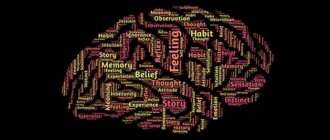What is deviation - concept
Deviation is a deviation from a behavioral norm. The concept of deviation is described in Efremova’s explanatory dictionary - (from Latin deviatio - deviation) deviation, change in development, condition, movement, etc. something under the influence of smb. external forces, conditions, etc. (Explanatory Dictionary of the Russian Language, edited by Efremova, 2012).
Deviation in sociology is a stable behavior of an individual, deviating from generally accepted, most widespread and established social norms, illegal actions.
The definition of deviation in social science is the motivational actions of an individual, which are fundamentally different from generally accepted values and rules of behavior in society, formed in a given culture or state.
How to write a term paper on speech therapy
07.09.2010 244947
These guidelines are compiled to help students gain an understanding of the content and structure of coursework in speech therapy.
Logopedia of pedagogical science that studies anomalies of speech development with normal hearing, explores the manifestations, nature and mechanisms of speech disorders, develops the scientific basis for overcoming and preventing them means of special training and education.
The subject of speech therapy as a science is speech disorders and the process of training and education of persons with speech disorders.
The object of study is a person suffering from a speech disorder.
The main task of speech therapy as a science is the study, prevention and elimination of various types of speech disorders.
Coursework in speech therapy is a student's scientific and experimental research. This type of educational activity, provided for by the educational and professional program and curriculum, contributes to the acquisition of skills in working with literature, analyzing and summarizing literary sources in order to determine the range of insufficiently studied problems, determining the content and methods of experimental research, processing skills and qualitative analysis of the results obtained. The need to complete coursework in speech therapy is due to the updating of knowledge concerning the content, organization, principles, methods and techniques of speech therapy work.
As a rule, during their studies, students must write two term papers - theoretical and practical.
The first course work should be devoted to the analysis and synthesis of general and specialized literature on the chosen topic. Based on this analysis, it is necessary to justify and develop a method of ascertaining (diagnostic) experiment.
In the second course work, it is necessary to provide an analysis of the results obtained during the ascertaining experiment, as well as determine the directions and content of speech therapy work, and select adequate methods and techniques of correction.
So, let’s present the general requirements for the content and design of coursework in speech therapy.
The initial and most important stage of working on a course project is the choice of a topic, which is either proposed by the supervisor or chosen by the student independently from a list of topics that are consistent with the areas of scientific research of the department.
Each topic can be modified, considered in different aspects, but taking into account a theoretical and practical approach. Having chosen a topic, the student needs to think through in detail its specific content, areas of work, practical material, etc., which should be reflected both in the formulation of the topic and in the further construction of the study. It should be recalled that the chosen topic may not only have a purely theoretical orientation, for example: “Dysarthria. Characteristics of the defect”, “Classification of dysgraphia”, but also take into account the practical significance of the problem under consideration, for example: “Speech therapy work on speech correction for dysarthria”. It should also be taken into account that when formulating a topic, excessive detail should be avoided, for example: “Formation of prosodic components of speech in preschoolers of the sixth year of life attending a preschool institution for children with severe speech impairments.”
The course work includes such mandatory parts as: introduction, three chapters, conclusion, bibliography and appendix.
The text of the term paper begins with the title page . An example of its design can be seen here.
Then the content of the work is given, in which the names of chapters, paragraphs, and sections are formulated in strict accordance with the content of the thesis. An example of its design can be seen here.
In the text, each subsequent chapter and paragraph begins on a new page. At the end of each chapter, the materials are summarized and conclusions are formulated.
The introduction reveals the relevance of the problem under consideration in general and the topic being studied in particular; the problem, subject, object, and purpose of the study are defined. In accordance with the goal and hypothesis, objectives and a set of research methods aimed at achieving the objectives must be defined.
The relevance of the topic lies in reflecting the current level of pedagogical science and practice, meeting the requirements of novelty and usefulness.
When defining the research problem, it is important to indicate what practical tasks it will help to implement in training and educating people with speech pathology.
The object of research is understood as certain aspects of pedagogical reality, perceived through a system of theoretical and practical knowledge. The ultimate goal of any research is to improve this object.
The subject of research is some part, property, element of an object, i.e. the subject of research always indicates a specific aspect of the object that is to be studied and about which the researcher wants to gain new knowledge. An object is a part of an object.
You can give an example of the formulation of the object, subject and problem of research:
– The object of the study is the speech activity of preschool children with phonetic-phonemic speech disorders.
– The subject of the study is the features of intonation speech of children with phonetic-phonemic speech disorders.
– The research problem is to determine effective directions for speech therapy work on the formation of intonation expressiveness of speech in the system of correctional intervention.
The purpose of the study contributes to the specification of the object being studied. The goal of any research is to solve a specific problem. The goal is specified in tasks taking into account the subject of research.
The research objectives are formulated in a certain sequence, which determines the logic of the research. The research objectives are set on the basis of a theoretical analysis of the problem and an assessment of the state of its solution in practice.
The first chapter is an analysis of literary sources, which examines the state of this problem in historical and modern aspects, and presents the most important theoretical principles that formed the basis of the study.
When writing the first chapter, you should pay attention to the fact that the text of the course work must be written in a scientific style. When presenting scientific material, it is necessary to comply with the following requirements:
– Specificity – a review of only those sources that are necessary to disclose only a given topic or solve only a given problem;
– Clarity – which is characterized by semantic coherence and integrity of individual parts of the text;
– Logicality – which provides for a certain structure of presentation of the material;
– Reasoning – evidence of thoughts (why this and not otherwise);
– Precision of wording, excluding ambiguous interpretation of the authors’ statements.
A literary review of the state of the problem being studied should not be reduced to a consistent presentation of literary sources. It should present a generalized description of the literature: highlight the main directions (currents, concepts, points of view), analyze in detail and evaluate the most fundamental works of representatives of these directions.
When writing a work, the student must correctly use literary materials, make references to the authors and sources from which the results of scientific research are borrowed. Failure to provide required references will reduce your coursework grade.
As a rule, in coursework on speech therapy, references to literary sources are formatted as follows: the number of the cited source in the general list of references is placed in square brackets. For example: General speech underdevelopment is a speech pathology in which there is a persistent lag in the formation of all components of the language system: phonetics, vocabulary and grammar [17].
When using quotations, in square brackets, in addition to indicating the source number, the page number from which this excerpt is taken is indicated, for example: Speech rhythm is based on a physiological and intellectual basis, since, firstly, it is directly related to the rhythm of breathing. Secondly, being an element that performs a communicative function, “correlates with meaning, i.e. controlled intellectually” [23, P.40].
However, course work should not be of a purely abstract nature, so you should not abuse the unreasonable abundance of citations. Quoting should be logically justified, convincing and used only when really necessary.
In the second chapter , devoted to experimental research, the organization should be described and the program of the ascertaining experiment should be presented. The survey methodology, as a rule, consists of a description of several series of tasks, with detailed instructions, visual and lexical material, the procedure for completing tasks by experiment participants, and scoring criteria. This chapter also provides a qualitative and quantitative analysis of the results obtained.
When analyzing the results of an experiment, it is necessary to use a scoring system. Examples of various criteria for quantitative and qualitative assessment are presented in the following works:
– Glukhov V.P. Formation of coherent speech in preschool children with general speech underdevelopment. - M.: Arkti, 2002. - 144 p.
– Fotekova T.A. Test methodology for diagnosing oral speech of primary schoolchildren. - M.: Arkti, 2000. - 56 p.
– Levchenko I.Yu. Pathopsychology: Theory and practice. - M.: Academy, 2000. - 232 p.
In order to visually present the results obtained during the experimental study, it is recommended to use tables, graphs, diagrams, etc. Histograms can be used in a variety of ways - columnar, cylindrical, planar, volumetric, etc. An example of the design of tables, figures, and histograms can be found here.
The third chapter provides a rationale for the proposed methods and techniques and reveals the content of the main stages of correctional work.
The conclusion contains a summary of the material presented and the main conclusions formulated by the author.
The bibliography must contain at least 25 sources. The list includes bibliographic information about the sources used in preparing the work. An example of its design can be seen here.
In the application you can present bulky tables or illustrations, examination protocols, observation records, products of activity (drawings, written works of children), notes from speech therapy classes, etc.
The volume of one course work must be at least 30 pages of typewritten text.
In general, coursework in speech therapy is the basis for a future thesis, in which the study of the begun problem can be continued, but from the standpoint of a different approach or a comparative analysis of the disorders being studied in different age categories of people with different types of speech disorders.
The content and format of theses in speech therapy can be found here.
Literature:
1. How to write a term paper on speech therapy: Methodological recommendations. Educational and methodological manual / Comp. Artemova E.E., Tishina L.A. / Ed. Orlova O.S. – M.: MGOPU, 2008. – 35 p.
2. Research work of students in the system of higher professional pedagogical education (specialty 031800 - Speech therapy). Methodological recommendations for completing the thesis / Compiled by. L.V. Lopatina, V.I. Lipakova, G.G. Golubeva. - St. Petersburg: Publishing house of the Russian State Pedagogical University named after. A. I. Herzen, 2002. - 140 p.
Theories of deviation with examples from life
There are many theories of deviations, but their essence can be reduced to 3.
| Deviation theory. | Description. | Example. |
| Biological. | Cesare Lombroso worked on the theory of deviations. He studied criminology and believed that the reason for breaking the law is the innate depravity of a person. | A person exhibits deviant behavior due to high testosterone levels, genetic predisposition, extra chromosomes, and lack of brain structures that are responsible for empathy. |
| Psychological. | This theory of deviation is supported by many psychologists, including Sigmund Freud. The essence of the theory is that deviants are not born, but become deviants due to negative life conditions. | A person’s experience of moral, physical, sexual violence, psychological trauma. |
| Social. | They represent the connection between deviant behavior and the conditions of the sociocultural environment. | Quetelet studied this theory, citing as evidence the fact that crime and cruelty are developed in disadvantaged areas. |
Causes of deviation
There is no consensus yet on what causes deviations from the norm. Some schools prioritize education in a dysfunctional family. According to other versions, the causes of deviation lie in mental problems; deviations in biological development or in the structure of DNA. Each of these versions has both advantages and disadvantages. If we talk about criminal tendencies, then people who grew up in a complete family and pupils of single-parent families and orphanages are equally susceptible to them.
Types of deviation
All deviations can be divided into two large groups - violations of generally accepted norms of social life and mental deviations .
These two large groups include different types of deviations and ways of considering them.
Social deviation
The basis of social deviation is motivation. Social deviation is the only type of deviant behavior that can be both positive and negative.
Examples of negative social deviation:
- vagabond lifestyle, lack of permanent residence;
- constantly asking for alms from others;
- trade in one's own body;
- being on the street or in public places under the influence of alcohol or drugs;
- a monastic lifestyle, in which a person renounces all earthly goods (participation in sects is also a social deviation);
- brilliant people who work for an idea (while not always looking neat, saying strange things, etc.);
- sadistic behavior, vandalism;
- lawbreakers (thieves, murderers, car thieves, etc.).
Examples of positive social deviation:
heroic deeds;
making significant scientific discoveries that completely change the life of society;
organizing rallies and struggles for equality;
geographical, historical discoveries.
Sexual deviation
It is sometimes difficult to separate sexual deviation from the norm; many sociologists and psychologists have tried to do this.
Ray Blanchard believes that normal sexual behavior is:
- oral sex;
- anal and vaginal penetration;
- masturbation, including mutual;
- kisses.
Deviation from the norm and deviant sexual behavior is considered:
- sexual interest in the products of human activity;
- desire to come into contact with persons with obvious physical disabilities;
- manifestation of sexual cruelty towards a partner (BDSM).
Gender deviation
This type of social deviation is subject to criticism and heated debate.
The essence of gender deviation is due to the fact that at birth a child is taught a certain gender model of behavior. For example, girls are dressed in light clothes, taught to preen themselves, and instilled in a love of jewelry and cosmetics. Boys are bought equipment as toys, dressed in simple and comfortable clothes, and are taught toughness in character (“be a man,” “boys don’t cry”).
These behavior patterns are subsequently reinforced. If a discrepancy occurs, it is considered a deviation and is condemned by society.
For example, they speak disapprovingly of girls who go to serve in the army or of guys who decide to wear makeup.
Communication deviations
There are a number of communicative deviations that are associated with the developmental characteristics of a particular personality:
- Autism. The phenomenon may be congenital or formed due to improper upbringing or prolonged exposure to a stressful situation. Such people strive for loneliness, they are bad at establishing contacts with society.
- Hypersociality. Hypersocial people are sensitive to loneliness; they strive to communicate with as many people as possible. Such sociability has a pathological form and differs from ordinary love to talk.
- Presence of phobias or fears. Almost all people have phobias and fears, but some of them can seriously interfere with successful social interaction. For example, the fear of blushing in public or appearing funny.
Teenage deviations
In their work, teachers and social psychologists often encounter deviant behavior of adolescents. Teenage deviations are:
- extremism, terrorism;
- violation of current legislation;
- addiction to bad habits;
- defiant appearance;
- impaired response in ordinary life situations;
- addiction to gambling;
- cruelty to animals, destruction of nature;
- severe forms of egoism, egocentrism;
- desire to minimize social contacts;
- habit of swearing and using foul language;
- ignoring the words of adults, their comments and demands;
- inability or unwillingness to control one’s own behavior;
- constant interruptions in mood, which lead to disruption of the nervous system;
- aggression, desire to damage oneself;
- the desire to solve any problems through a fight;
- attempts to die.
Teenagers can also demonstrate positive deviations:
- increased talent, genius, success in the fields of science or art;
- high level of patriotic education;
- performing significant actions for the benefit of society;
- the ability to sacrifice oneself for the sake of a common cause or the good of another person;
- a desire to help others, a heightened sense of mercy, self-sacrifice;
- high degree of hard work, sense of duty;
- unique human abilities.
Types of social deviation
Since we are talking about both personal and group deviations, it is worth mentioning a fairly wide group and typological division of social deviations. It is carried out according to cultural and psychological characteristics, depending on group or individual distribution, as well as on the degree of its occurrence.
Thus, there are some cultural and mental deviations that determine the social deviation of people or wider social groups. In this case, sociologists are specifically interested in cultural deviations, since they determine the characteristics of deviant behavior due to cultural differences and reluctance to obey specific cultural norms that operate within a community.
Finished works on a similar topic
Course work Social deviation 420 ₽ Essay Social deviation 250 ₽ Test work Social deviation 210 ₽
Receive completed work or specialist advice on your educational project Find out the cost
Considering the specific division of social deviation into individual and group, it is worth noting that individual deviation is understood as the rejection of the norms of one’s culture and community on the part of an individual. Group, in turn, means opposition to public interests on the part of a wider social group.
Deviations and manifestations of deviation can be primary and secondary. Primary deviation implies that, in general, a person’s behavior and social actions correspond to the cultural norms that society has. As for the secondary deviation and manifestation of deviation, in this case it is a fatal deviation from accepted norms, which is defined as deviant, asocial, carrying quite negative consequences.
Social deviance can be culturally approved or culturally rejected. Culturally approved forms of social deviation include hyperintellectual behavior, increased motivation of the individual, as well as his achievements, which are based on personal qualities and talent that the individual displays in specific situations. Culturally condemned social deviation supports social deviations that are destructive and can harm not only the bearer of such behavior, but also the people around him.
Forms of deviation
Forms of deviation are divided into positive, negative and neutral .
Negatively colored deviation is various types of addiction, violations of the law, and cruel behavior.
Positive deviation can include donating benefits for the development of society, performing any significant work for free.
Socially neutral deviations include reluctance to start a family, excessive shyness or isolation.
Types of deviation and examples
In modern science, Merton identified deviation, which can be divided into 5 types.
| Type of deviant behavior. | Description. | Example. |
| Delinquent type. | Causing some harm to others and society in order to have fun or draw attention to oneself. Sometimes these are illegal actions, frivolous acts (they can be committed at the suggestion of other people). Often this behavior is demonstrated by people with unresolved internal conflicts. | Rock musicians who cause riots or engage in vandalism. |
| Addictive type. | A person wants to change his condition artificially in order to be able to escape reality (taking psychoactive substances, drugs, alcoholic beverages). A person in real life cannot find activities and emotions that would satisfy him. | Many creative people had addictive behavior: Lewis Carroll, Honore de Balzac, Edith Piaf, Mikhail Bulgakov, William Faulkner, Truman Capote. |
| Pathocharacterological type. | A person’s behavior is caused by changes in his character due to improper upbringing or lack thereof. This is often characterized by personality disorders or character accentuations. | A person with a schizoid personality type stops communicating with friends, parents and colleagues without explanation. |
| Psychopathological type. | This is a manifestation of mental disorders and diseases. A person suffers from hallucinations, thinking disorders, and commits actions incomprehensible to a healthy person. | The main character of the movie "Split" or the book "The Many Minds of Billy Milligan." |
| Based on hyperpowers. | A person exists in parallel in two worlds, his own and the real. A person perceives the real world as not too significant; he tries not to interact with it. Usually such people are eccentric and do not want to enter into close contacts or close relationships with them. | Alexander Suvorov woke up every night at exactly 2 o’clock to douse himself with cold water and crow like a cock. He could meet guests in only his underwear. |
There is another classification of types of deviant behavior.
| Type of deviant behavior. | Characteristic. | Example. |
| Innovator. | People want to succeed in society and be full members of it, but they prefer to follow their own path of development. | Creators of financial pyramids, businessmen, cooperators. |
| Ritualists. | Such people often bring social principles to the point of absurdity and try to change the existing system. | Citizens who regularly organize rallies and strikes. |
| Retreatists. | Escape from existing reality, the desire to escape from reality, rejection of generally accepted goals and ways of their implementation. | People without a fixed place of residence, drug addicts, alcoholics, tramps. |
| Revolutionaries. | People who are not satisfied with the existing social system, they want to replace it with a new one. | There are many revolutionaries among historical figures: Vladimir Lenin, Leon Trotsky, Karl Marx, Fidel Castro and others. |
What do you think about types of deviant behavior? Do you know any interesting examples? Be sure to share them in the comments, and we’ll discuss them together.
General characteristics of social deviations
The concept of deviation in sociology
The word “deviation” is literally translated from the Late Latin deviatio
as a deviation.
This term is also common in other sciences, such as physics and biology. It came to sociology relatively recently and is used to denote various types of behavior that deviate from the normal.
There is no such society in which all its members would behave in accordance with general normative requirements. The term “deviation” or “social deviation” refers to the behavior of an individual or group that does not correspond to generally accepted norms, as a result of which these norms are violated by them. Social deviance can take many different forms.
Youth criminals, hermits, ascetics, inveterate sinners, saints, geniuses, innovative artists, famous athletes, murderers - all these are people who deviate from generally accepted norms, or, as they are also called, deviants. Deviation threatens to disrupt the stability of society, which has always been valued above all else.
In Russian sociology, the term “deviation” is used in two meanings – broad and narrow. In a broad sense
the term “deviance” implies any deviation from social norms accepted in society. These could be minor offenses, such as being late for work, or, conversely, a manifestation of heroism, self-sacrifice, or genius. But it can also be a serious crime, such as murder.
In the narrow sense
Deviance refers to minor offenses that do not fall under criminal or even administrative codes.
For more serious forms of violation the term delinquency and crime are used.
Let's try to classify the most common social deviations and give them a brief description.
Individual and group deviations . If we encounter individual deviations from the norm within one subculture, then such a person is usually considered an individual deviant.
For example, the most ordinary boy from a stable family, surrounded by decent people, can reject the norms accepted in his environment and show clear signs of criminal behavior (become a delinquent).
At the same time, in every society there are many deviant subcultures, the norms of which are condemned by the generally accepted, dominant morality of society.
For example, teenagers from difficult families spend most of their time in basements. “Basement life” seems normal to them; they have their own “basement” moral code, their own laws and cultural complexes.
In this case, there is not an individual, but a group deviation from the norms of the dominant culture, since adolescents live in accordance with the norms of their own subculture. The subculture in this case contains patterns of behavior introduced by individual deviants.
Primary and secondary deviations . The concept of primary and secondary deviations was first formulated and developed in detail by E. Lamert.
Primary deviation refers to deviant behavior of an individual, which generally corresponds to cultural norms accepted in society. In this case, the deviations committed by the individual are so insignificant and tolerable that he is not socially classified as a deviant and does not consider himself such.
For example, manifestations of ex, with the help of which a person tries to stand out, impress others, even the mistakes people make are not perceived by others as deviance.
Secondary deviation is a deviation from existing norms in a group, which is socially defined as deviant. In this case, the person is identified as a deviant.
Culturally approved and condemned deviations . Deviant behavior is always assessed from the point of view of the culture accepted in a given society. This assessment is that some deviations are condemned, while others are approved.
For example, a wandering monk may be considered a saint in one society, but a worthless slacker in another. In our society, people who fall under the definition of a genius, a hero, a leader, or the chosen one of the people are culturally approved deviations.
A characteristic feature of deviant behavior is that it should be viewed from the perspective of cultural relativism.
This means that a social norm, adopted either by unwritten tradition or by law, is a very relative phenomenon. The same act can be considered positive in one society, but in another it can be assessed as a social deviation.
For example, in primitive times, cannibalism (people eating their own kind), geronticide (killing old people), incest and infanticide (killing children) were considered normal phenomena caused by economic reasons (scarcity of food) or social structure (permission of marriage between relatives). But in modern society this is considered deviant, and in some cases, absolutely criminal behavior.
Criteria for deviance often change over time, even within the same culture.
After World War II, smoking became widespread in the United States and actually gained social approval. Cigarettes were advertised by Hollywood stars and even athletes. Smoking in an apartment or office was considered normal behavior. But in 1957, scientists proved that smoking is the cause of many serious diseases, including lung cancer. Gradually, the general public began a campaign against smoking. And in the 90s, smoking in all indoor public spaces in some large US cities was prohibited by law.
Deviant behavior is the most widespread type of behavioral disorder. However, it comes down not only to numerous violations of public and administrative order. In addition to the negative meaning, the word “deviance” also has a positive meaning.
Having set the goal of studying the variety of forms of manifestation of deviant behavior, the American sociologist R. Keven built a theoretical model that describes the interaction of the individual and society. She proposed a continuum of types of behavior from extreme deviation with the lowest level of conformity, through intermediate forms of more or less correct behavior, to extreme deviation with “overconformism.” R. Keven's scheme represents a Gaussian curve on a horizontal line, divided into 7 equal segments.
| + |
Signs of deviant behavior
In modern society, a number of rules and norms of behavior have been adopted. Violations are signs of deviation, deviant behavior:
- Aggressiveness, too tough temperament.
- An increased form of egocentrism.
- Inability to adequately perceive criticism and respond to it.
- Changes in mood for no apparent reason.
- Inability to independently control one’s speech and actions.
- Inability to take care of yourself.
- Increased isolation, desire to constantly be alone.
- Mental or psychosomatic system disorders.
- Communication with criminal personalities, a person’s connection with the criminal world.
- A person's desire to aggressively oppose the opinions of the majority of members of society.
Reminder about deviation
Causes of deviation
Psychologists identify quite a few reasons for the emergence of deviation:
- genetic predisposition to deviant behavior;
- adolescence (the individual is formed, often through deviant behavior he learns the boundaries of what is permitted in society);
- low level of intellectual development of the individual;
- certain character traits (tendency to rebellion, aggression, opposition);
- unfavorable financial situation in the family or region of residence;
- pronounced social inequality;
- unstable political situation in the country;
- raising a child in disadvantaged conditions;
- serious mistakes in education;
- reluctance of parents to work on the moral education of the child;
- child copying incorrect patterns of behavior;
- the inability of the individual to successfully socialize;
- high levels of stress;
- disorders of the brain or central nervous system;
- psychosomatic problems, disorders;
- difficulties in choosing the only correct model of behavior (parents say one thing, friends say another, TV says something else);
- inability to realize one’s interests and needs;
- confidence in one’s own impunity, manifestation of permissiveness;
- the habit of shifting responsibility for one’s life to other people;
- the desire to become famous, but the inability to achieve recognition in the field of art, science, sports, etc.;
- desire to gain approval from the company;
- the desire to look cool and mature in the eyes of others;
- destructive desire to change the world.
We invite you to watch a video lecture on the influence of the Internet on deviant behavior.
Stages of formation
The main stages and causes of deviant behavior are laid down in adolescence. A person gets to know himself, asserts himself, strives to stand out from other people.
At the first stage, a person demonstrates deviant behavior that is not approved in a particular society (plays pranks in class, talks loudly, hooligans on the street). Usually behavior is corrected by educators, teachers or parents. If measures were not taken at the first stage, then over time the violations may become more significant.
At the second stage, the teenager commits clearly condemnable deviant behavior (swears, fights, mocks classmates). Disciplinary measures must be taken against such a child.
At the third stage, deviant behavior takes root, the person regularly demonstrates deviations in his words and actions. His behavior can be characterized as morally negative (he is regularly rude to teachers, refuses to do homework, disappears on the street until late). Such a teenager needs systematic correctional work.
At the fourth stage, the individual’s behavior can be characterized as illegal, with regular relapses (vandalism, hooliganism, petty theft). Specially trained people (social educator, law enforcement officers, psychologist) should work with such minors.
The fifth stage is the criminal behavior of the individual. Typically, work with such adolescents is carried out in special closed correctional institutions.
Prevention of deviant behavior
To create behavioral stability in children and adolescents and avoid deviations, it is worth:
- Develop an interest in the world around you (this needs to be done in the family and educational institutions).
- Introduce the child to the rules and norms of behavior in various life situations, conduct play or training sessions.
- Help in developing adequate self-esteem.
- Develop communication skills with different categories of people, allow you to practice.
- Work on the family microclimate and improve parent-child relationships.
Correction of deviant behavior
Negative deviations need to be corrected in childhood and adolescence.
Help with adaptation
Help the deviant adapt, do not set initially impossible tasks for him, and be more lenient towards him.
For example, a child is used to solving any issue through a fight. You should not expect that a child with deviant behavior will stop fighting immediately after the conversation. It is important to celebrate any achievements of the child and not devalue them (clenched his fists, but did not hit the interlocutor; called him an insult, but did not fight; raised his voice, but resolved the issue without the participation of his fists).
Team involvement
Involve the deviant in collective activities, give the opportunity to realize their creative abilities.
For example, a teenager in chemistry lessons constantly misbehaves and interferes with others. You can give a deviant student the task of studying terms and preparing a series of experiments, and demonstrating them to the whole class in the next lesson. A fighter in a physical education lesson can demonstrate hand-to-hand combat techniques. An overly active student can be given the opportunity to perform a dance at a school concert.
Help achieve success
Organize situations in which the child can achieve success (it is worth developing incentive measures for success).
For example, a teacher knows that a particular student exhibits deviant behavior, but loves to read fantasy books. It is worth giving the deviant the opportunity in class to talk about his favorite author or prepare a message about his favorite work. You can reward your efforts with a good grade or applause.
Deviant behavior: causes, types, forms
Deviant behavior: reasons,
types, forms.
Contrasting oneself to society, one’s own approach to life and socially normative behavior can manifest itself not only in the process of personal formation and development, but also along the path of all kinds of deviations from the acceptable norm. In this case, it is customary to talk about deviations
and
deviant
human behavior.
In most approaches, the concept of deviant behavior
associated with deviant or antisocial behavior of an individual.
It is emphasized that this behavior represents actions (of a systemic or individual nature) that run counter to the norms accepted in society, regardless of whether they (the norms) are legally enshrined or exist as traditions and customs of a particular social environment.
A person manifests himself in this way due to inadequate personal formation in the process of socialization and mastery of moral norms, foundations and rules. Such a person’s own behavior (from the point of view of standards of public morality) is controlled to a very small extent.
Pedagogy and psychology, being the sciences about man, the peculiarities of his upbringing and development, focus their attention on the general characteristic signs of deviant behavior:
- an anomaly of behavior is activated when it is necessary to fulfill the (important and significant) social standards of morality accepted in society;
- the presence of damage that “spreads” quite widely: starting from one’s own personality (auto-aggression), surrounding people (groups of people), and ending with material items (objects);
- low social adaptation and self-realization (desocialization) of an individual who violates norms.
It is safe to say that deviation and social maladaptation/isolation are equivalent concepts, since a person cannot successfully exist in a certain (normal, everyday) social environment. That is, he has deviations from the point of view of average behavior, characteristic of most people as representatives of society.
Therefore, people with deviation, especially adolescents (this is the age that is unusually susceptible to behavioral deviations), are characterized by specific properties:
- affective and impulsive reactions;
- significant (charged) inadequate reactions;
- undifferentiated direction of reactions to events (they do not distinguish the specifics of situations);
- behavioral reactions can be called persistently repeated, long-term and repeated;
- high level of readiness for antisocial behavior.
Types of deviant behavior:
Social norms and deviant behavior in combination with each other provide an understanding of several types of deviant behavior (depending on the direction of behavior patterns and manifestations in the social environment):
- Antisocial
. This behavior reflects a person’s tendency to commit actions that threaten successful interpersonal relationships: by violating moral norms that are recognized by all members of a particular microsociety, a person with deviation destroys the established order of interpersonal interaction. All this is accompanied by multiple manifestations: aggression, sexual deviations, gambling addiction, dependency, vagrancy, etc.
- Antisocial
, another name for it is
delinquent
. Deviant and delinquent behavior are often completely identified, although delinquent behavioral cliches concern narrower issues - they have as their “subject” violations of legal norms, which leads to a threat to social order and disruption of the well-being of people around them. These can be a variety of actions (or lack thereof) directly or indirectly prohibited by current legislative (regulatory) acts. - Autodestructive
. It manifests itself in behavior that threatens the integrity of the individual, the possibilities of his development and normal existence in society. This type of behavior is expressed in different ways: through suicidal tendencies, food and chemical addictions, activities with a significant threat to life, as well as autistic/victim/fanatical behavior patterns.
Forms of deviant behavior are systematized based on social manifestations:
- negatively colored (all kinds of addictions - alcohol, chemical; criminal and destructive behavior);
- positively colored (social creativity, altruistic self-sacrifice);
- socially neutral (vagrancy, begging).
Depending on the content of behavioral manifestations of deviations, they are divided into types:
- Addictive behavior
. The object of desire (dependence on it) can be various objects:
- psychoactive and chemical drugs (alcohol, tobacco, toxic and medicinal substances, drugs),
- games (activating gambling behavior),
- sexual satisfaction,
- Internet resources,
- religion,
- shopping, etc.
- Aggressive behavior
. It is expressed in motivated destructive behavior causing damage to inanimate objects/objects and physical/mental suffering to animate objects (people, animals).
- Victive behavior
. Due to a number of personal characteristics (passivity, unwillingness to be responsible for oneself, to defend one’s principles, cowardice, lack of independence and an attitude of subordination), a person is characterized by victim behavior patterns.
- Suicidal tendencies and suicides
. Suicidal behavior is a type of deviant behavior that involves a demonstration or actual attempt at suicide. These behavioral patterns are considered:
- With internal
manifestation (thoughts about suicide, reluctance to live in current circumstances, fantasies about one’s own death, plans and intentions regarding suicide);
- With external
manifestation (suicide attempts, actual suicide).
- Running away from home and vagrancy
. The individual is prone to chaotic and constant changes of place of residence, continuous movement from one territory to another. They have to ensure their existence by begging for alms, stealing, etc.
- Illegal behavior. Various manifestations in terms of offenses. The most obvious examples are theft, fraud, extortion, robbery and hooliganism, vandalism. Beginning in adolescence as an attempt to assert oneself, this behavior is then consolidated as a way of building interaction with society.
- Sexual behavior disorder
. Manifests itself in the form of abnormal forms of sexual activity (early sexual activity, promiscuity, satisfaction of sexual desire in a perverted form).
Causes
Deviant behavior is considered an intermediate link between normality and pathology.
When considering what causes deviance, most studies focus on the following groups:
- Psychobiological
factors (hereditary diseases, features of perinatal development, gender, age-related crises, unconscious drives and psychodynamic features).
- Social
factors:
- features of family upbringing (role and functional anomalies in the family, material capabilities, parenting style, family traditions and values, family attitude towards deviant behavior);
- the surrounding society (the presence of social norms and their real/formal compliance/non-compliance, society’s tolerance for deviations, the presence/absence of means of preventing deviant behavior);
- influence of the media (frequency and detail of broadcasting acts of violence, attractiveness of images of people with deviant behavior, bias in informing about the consequences of manifestations of deviance).
- Personal
factors.
- disturbance of the emotional sphere (increased anxiety, decreased empathy, negative mood, internal conflict, depression, etc.);
- distortion of the self-concept (inadequate self-identity and social identity, biased self-image, inadequate self-esteem and lack of confidence in oneself and one’s strengths);
- distortion of the cognitive sphere (lack of understanding of one’s life prospects, distorted life attitudes, experience of deviant actions, lack of understanding of their real consequences, low level of reflection).
Prevention
Early age-related prevention of deviant behavior will help to effectively increase personal control over negative manifestations.
It is necessary to clearly understand that children have signs indicating the onset of deviation:
- manifestations of outbursts of anger that are unusual for the child’s age (frequent and poorly controlled);
- using intentional behavior to annoy an adult;
- active refusals to comply with the demands of adults, violation of the rules established by them;
- frequent confrontation with adults in the form of arguments;
- manifestation of anger and vindictiveness;
- the child often becomes the instigator of a fight;
- deliberate destruction of someone else's property (objects);
- causing harm to other people using dangerous objects (weapons).
A number of preventive measures implemented at all levels of society (national, regulatory, medical, sanitary, pedagogical, socio-psychological) have a positive effect on overcoming the prevalence of deviant behavior:
- Formation of a favorable social environment
. With the help of social factors, an individual’s undesirable behavior with possible deviation is influenced - a negative background is created regarding any manifestations of deviant behavior.
- Information factors
. Specially organized work to provide maximum information about deviations in order to activate the cognitive processes of each individual (conversations, lectures, creation of videos, blogs, etc.).
- Social skills training
. It is carried out with the aim of improving adaptability to society: social deviation is prevented through training work to build resistance to abnormal social influence on the individual, increase self-confidence, and develop self-realization skills.
- Initiating activities that are opposite to deviant behavior
. Such forms of activity can be:
- testing oneself “for strength” (risky sports, mountain climbing),
- learning new things (travel, mastering complex professions),
- confidential communication (helping those who have “stumbled”),
- creation.
- Activation of personal resources
. Personal development, starting from childhood and adolescence: involvement in sports, personal growth groups, self-actualization and self-expression. An individual learns to be himself, to be able to defend his opinions and principles within the framework of generally accepted moral norms.
Only with the adequate formation of a person as a personality, an understanding of deviant behavior as an unacceptable and unacceptable form of interaction between the individual and society is created in his consciousness.











